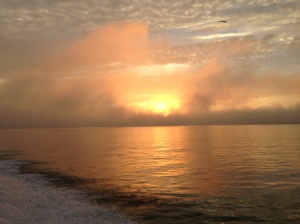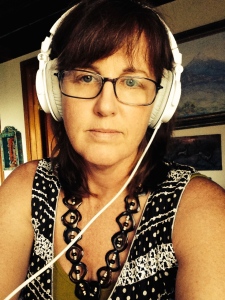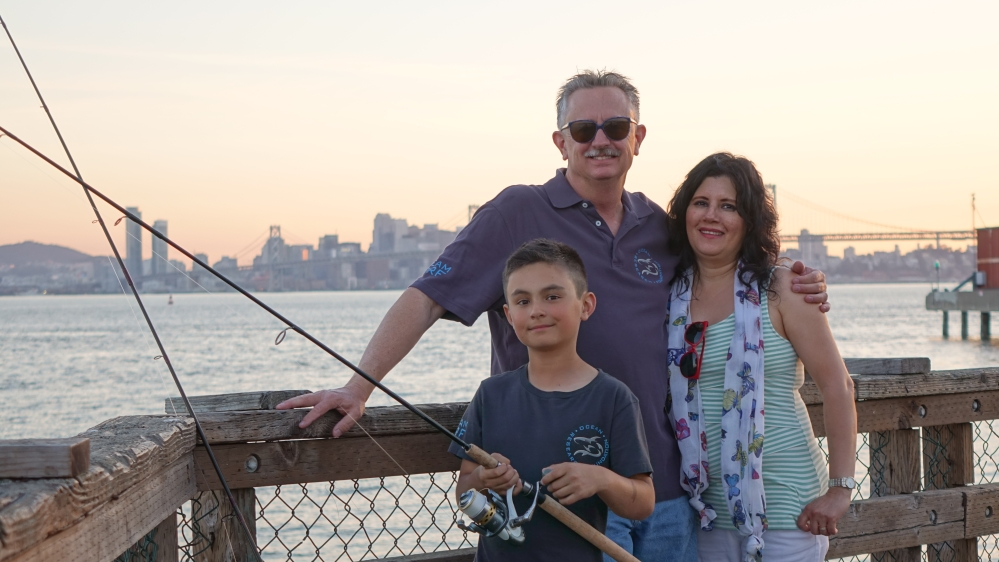F.Y.I. SINCE I WROTE THIS, MY SHORT DOC, “STEVE SHIRLEY SHARK TAGGER” HAS BEEN OFFICIALLY SELECTED INTO THE WILDLIFE CONSERVATION FILM FESTIVAL AND THE SAN FRANCISCO INTERNATIONAL OCEAN FILM FESTIVAL. I’M STILL WAITING TO HERE FROM OTHERS…

Photo by Kristin Sherman Olnes
Speeding from a boat on the San Francisco Bay at dawn .
It was two days after Thanksgiving, 2013, that I interviewed Steve Shirley near the Golden Gate Bridge and digitally filmed his Sevengill Shark tagging trip. A year later, here’s what I learned about making my short documentary.
Up before dawn, with a crew of three men and a boy, we headed out of the Berkeley Marina in Steve’s boat into the San Francisco Bay. The medicated patches I had placed under my ear lobes to prevent seasickness had fallen off in the dark parking lot. “Oh well, here we go,” I thought. I held my breath and my camera steady as I filmed the rising sun with a big ol’ grin.
Being the only female out there reminded me of ‘tomboy-self’ when I was nine, on a quail-hunting trip with my Dad, his hunting buddies, and my brother. Although it sort of felt like a test on whether I could keep up with the men, I was feeling good. Being an independent documentary filmmaker for my own National Geographic-like production was happening, as a result of my self-directed learning and effort. I’m not trying to sound like a braggart.
I’m interested in promoting self-directed learning at Intrinsic Lifestyle and Intrinsic Lifestyle Productions.
Making my film was my intellectual and creative outlet, my escape. Normally, my routine as a homeschooling and a year-round swim team parent dominates my weekdays and weekends, in addition to housework, cooking, groceries, urban farming, and beekeeping. Then there’s my Mom, who lives next door to me with progressive MS; or helping/visiting my sister with stage four metastasized breast cancer.
Pre Production
Beginning my documentary was a combo-act of gathering information, for myself and from Steve. Having been a film student in the 80s, when I used Super 8 film for movies, I had oodles of digital technology to learn and film theory I wanted to revisit. I read the “bible” of the genre, “Directing the Documentary,” by Michael Rabiger. My sister advised me to read Hard Times: An Illustrated Oral History of the Great Depression, by Studs Terkel, to study his style of profiling people.
Due to the fast pace of technology (and poorly written manuals) the web was a phenomenal resource. I used on-line articles, reviews, comments, or video tutorials about cameras, lenses, digital video formats, resolutions, codecs, and microphones. I also studied indoor and outdoor lighting for HD film, story-telling, sweetening sound, as well as, videos and articles about Sevengill sharks.
The story in my film began to unfold between the drop-off/pick-up of our daughter at swim practice. I’d park my compact car by scenic Lake Merritt in Oakland. Sitting in my portable ‘office’ with an almond cappuccino from Cafe Trieste in the cup holder, I was grateful for my bluetooth hands-free phone set up. Steve’s voice transmitted through the speakers clearly, as he responded to my preliminary interview questions.
Our early interviews were crucial. It took a few calls and hour-long conversations for me to understand how Steve changed his mindset from sport fisherman to ocean conservationist. I wanted to ‘put a finger’ on his obsession for being near water and fishing his whole life. All the things he’d taught himself along the way to organize and to conduct his study were just as important to me as the people and the organizations he partnered with. I wanted to know everything he’d learned about sharks and how he caught them. (I didn’t want to teach others how to catch them, so we were careful not to give too many details about fishing for them away in my film.)
Production
When you look at San Francisco by the bay, you don’t usually think about the five species of sharks swimming in the water nearby. I showed this dichotomy in my film. But it took a few adventures to find the right place to conduct my last interview with Steve.
On weekends, I’d scout locations around the bay. My explorations were liberating. They reminded me of my college days at the University of Arizona in Tucson, when I’d enter abandoned adobes in the barrio viejo to take photographs. On bike rides, with my camera slung over my back, I’d stop and shoot b-roll video footage of the San Francisco Bay view from : Treasure Island, he Piedmont cemetery; and from the Alameda shoreline. I was also practicing using my new camera, a Sony RX10. I composed my shots to show the contrast of nature amidst an urban metropolis; a place where hundreds of thousands of people and industry thrive amidst sea birds, aquatic plants and sharks!
To decide when to shoot more interview footage of Steve with the bay behind him, I consulted tidal and weather charts and studied the light on the water. As a ‘crew-in-one,’ I practiced setting up my tripod, camera, wireless mic, and lights at home. Later, I lugged all of it to various locations at Middle Shore Harbor in Oakland, where I had pre-marked the ground for my tripod and filmed Steve for our last interview. We also met at his home, where he answered many of the questions we’d discussed on the phone, in his office, and in his basement.
Photo by Kristin Sherman Olnes
Steve Shirley, with his wife Lilia and their son, Gabe, at Middle Shore Harbor in Oakland, California.
Post-production Editing
I must have edited at least sixteen cuts of my film. But first, I logged all my shots and sounds. I sorted through Steve’s photographs and his Go Pro video footage. I selected photos from his childhood, Ocean Research Foundation events, and shark tagging trips with scientists and volunteers.
I learned the technical side of how to use the editing software by reading, “Final Cut Pro X 10.1: Professional Post-Production,” by Brendan Boykin. I watched a lot of films closely to study the editing and the sound. I sought the help of others because I was too close to my work to see flaws in it.
It was my fortune to meet with an MFA Tisch School of the Arts film graduate, Erin King, (gush in admiration). She had worked for George Lucas’s documentary department as an Editor. She’d come over to my house and we watched the latest version of my film together. I took notes and continued editing, hours and hours of editing. I’m grateful for her constructive criticism, time, and encouragement. I also asked for feedback from three film-savvy friends to test the effectiveness of my ‘story.’
Post-production Sound
Steve requested that a song called, “Hook,” written and sung by San Francisco performer and photographer, Mike Gibbons, be in my film. I liked the melody and the words in the song were “catchy” but the recording I had was poor. Steve paid for Mike to re-record it with a few other musicians and a professional sound engineer in a studio. I used “Hook” in the beginning and the end of my film. I also wove my son’s acoustic guitar recordings into the film to create a mood.
When I thought I was done editing, I wanted to know where my film stood, professionally. I sought the help of an Academy Award Winner and someone I like to refer to as a ‘Sound Mixing Diva of San Francisco,’ since he prefers to remain anonymous. After twenty-five years, I cold-called the ‘SMD’ and reminded him who I was. I asked him if he’d take a look at my short doc and critique it.
I met with the ‘SMD’ in his swank Presidio studio. I expected negative feedback from him. After all, in comparison to the feature film legends he’s worked for, I’m a complete amateur. I respected his opinion. I knew that his perfectionism, along with the seventy-two feature films under his belt, got him where he’s at. So I sat on his couch mesmerized by his knowledge; his deep bass voice; and his willingness to help me out.
While we watched my film on Vimeo, I took copious notes. As he rewound sections over and over, I wondered what he noticed that I hadn’t. I knew each scene by heart, having looked at it hundreds of times. Honestly, I thought it was fine until he’d make a simple suggestion like, “Let that scene run longer” or, “Don’t cut off that word” or, “Why is that there?” Even though his criticisms were kind of deflating, I left energized and ready to remix the thing. And after trying out what he recommended and watching/hearing the result I knew his remarks were point on. It was nice to hear from him that my film had a sweet sincerity about it that he hoped I’d keep through more editing.
At home, I began re-mixing all the sounds: dialogue, effects, ambient noise, and music. In particular, he thought I should ‘play up’ the ‘documentary’ aspect of my film. He thought I’d ‘cleaned up’ Steve’s voice too much. We met one more time after that; and although I suspected there were many more things he would’ve done differently, the story was how I wanted it.
Improving the sounds made my film more cohesive. In particular, the SMDs advice to add more ambient sound made my story more interesting and ‘watchable.’ I think I learned the most from his process of reviewing the footage of a small sequence repeatedly. That made me more aware of the editing rhythm, and the balance between the audio and the visual.
In addition, I began listening to classical music, which helped me hear the construction of the sounds and their loudness in relation to one another. Watching 1940s b&w films was useful to. Very few sounds in early films made the scenes seemingly naked; and their absence revealed the necessity of ambient noise for the realism of a movie.

Doing all of that helped me mix an ‘environment of sounds’ in my film including: dialogue, ambience, sound effects, and music. It was tricky finding the balance between them. Although I did all the mixing myself, alone at my workstation wearing my dorky white headphones, which I wish were noise cancelling, I credit the ‘coming together’ of my film to the Sound Mixing Diva. I know I couldn’t have learned what he taught me in eight hours from a book, or in a class. I still have more to learn about the complicated, throughly engrossing process of sound mixing.
Post Production continues…
Throughout my project, the people who’ve helped humbled me. Interestingly, I’ve met and or followed many film professionals or independent filmmakers on Twitter. A documentary filmmaker, photographer, curator and professor from New York City, Ted Fisher, critiqued my film privately and emailed me comments. An Italian Visual Anthropologist teaching Ethnographic Documentary, Lorenzo Ferrarini, advised me about sound and distribution options. Cyrus from San Francisco, an Editor/Producer, helped me with FCPX 10.1 sound editing tips.
As of late, I’m figuring out how to distribute my short doc. Based on advice from the three men above, I used Withoutabox and Film Freeway to enter festivals. (See note at top of post.) I’ve also contacted museums like the Monterey Bay Aquarium, California Academy of Science, and the Oakland Museum of CA to get my film screened there. But I think my best option for the most people to see it is on our local KQED station.
I think with the threats our oceans are facing, there’s an inherent interest in marine life. Most people don’t know the role sharks play in the ecosystem or how threatened they are. Fisherman continue to catch and kill them as trophy’s for sport. Right now in California, people may catch a Sevengill or Leopard Shark of any size, every day of the year. As Steve says in my film, “That’s just too much!” He’s hoping that his study, in partnership with the Monterey Bay Aquarium, will eventually lead to more shark regulations.
There’s definitely a need for people to watch “Steve Shirley: Shark Tagger.” In my film, Steve guides viewers to understand and to care about Sevengill Sharks in the SF Bay.
